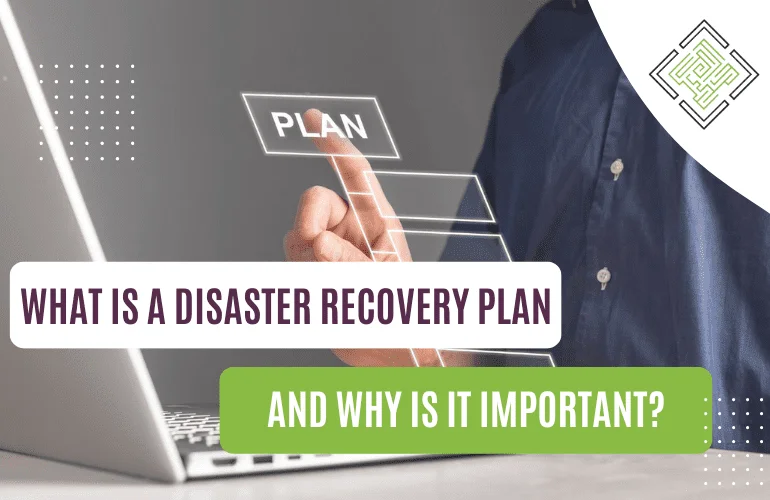
Did you know that disruptive events, both man-made and technological, can strike any organisation at any time? From sophisticated cyber attacks and data breaches to hardware failures, the potential threats to businesses and individuals are diverse and significant. In the face of such challenges, a disaster recovery plan becomes a lifeline – a comprehensive and structured strategy that outlines the steps and measures to recover swiftly and efficiently. It is not just large corporations that need these disaster recovery plans; small and medium-sized businesses (SMBs) are equally susceptible to the devastating consequences of disasters. Despite the risks, recent studies have revealed that a significant number of SMBs lack a formal disaster recovery plan.
In this article, we explore the paramount importance of disaster recovery plans, particularly for small and medium-sized businesses and delve into the essential components that constitute a well-constructed strategy. By understanding the significance of these plans and the potential consequences of not having one, businesses can fortify themselves against the unpredictable forces of disaster and secure their operations, data, and future.
The primary purpose of a disaster recovery plan is to enable an organisation to recover from a disaster swiftly and efficiently, minimising downtime and mitigating potential financial losses.
A disaster recovery plan is important for several crucial reasons, and its significance extends to organisations and individuals alike. Let’s explore why a disaster recovery plan is considered so important:

A well-constructed disaster recovery plan comprises several critical components that work together to ensure an organisation’s preparedness and resilience in the face of disasters or disruptive events. Each component plays a vital role in safeguarding operations, data, and assets, and when combined, they form a comprehensive strategy for effective disaster recovery.
The foundation of any disaster recovery plan begins with a thorough risk assessment and analysis. The journey begins with the identification of potential IT threats that could cast a shadow over an organisation’s technological infrastructure. From cyber attacks and data breaches to system failures and software vulnerabilities, the array of conceivable hazards in the digital realm is vast.
Delving into Risk Assessment and Analysis reveals not only external threats but also internal IT vulnerabilities. These vulnerabilities could emanate from outdated software, inadequate cyber security protocols, or lapses in data protection. The process of analysis exposes these weak points, providing organisations with an opportunity to bolster their IT security measures.
For examples, a financial institution conducting a risk assessment may identify the risk of a cyber attack as a severe threat due to the potential impact on customer data, financial stability, and reputation. Understanding the severity of potential disasters helps prioritise resources and allocate them effectively to address the most critical risks.
Building a comprehensive IT inventory is a fundamental step in disaster recovery planning, ensuring you have a detailed record of the systems, hardware, and software that drive your business operations. To bolster your disaster preparedness, compile a meticulous IT inventory detailing every essential component your business relies upon, from servers and workstations to vital software applications.
As an example, consider a financial institution that maintains a comprehensive IT inventory. In the event of a cyber incident affecting its core banking systems, this inventory would aid in identifying the affected components, understanding their dependencies, and prioritising the restoration process. This allows the institution to recover critical services swiftly and minimise the impact on customer transactions and financial operations.
To guide the recovery efforts effectively, the disaster recovery plan establishes Recovery Time Objectives (RTO) and Recovery Point Objectives (RPO). RTO specifies the maximum acceptable downtime for each critical process. In other words, it sets the time frame within which the organisation aims to restore operations after a disaster. RPO, on the other hand, indicates the maximum data loss the organisation can tolerate. It determines the amount of data that may be lost between the last data backup and the occurrence of the disaster.
For instance, an e-commerce company may set an RTO of four hours for its online order processing system, meaning that the system should be restored within four hours after a disaster to ensure minimal disruption to customer orders. The RPO might be set at one hour, implying that the data backups should be performed at least every hour to avoid significant data loss.
Data is a critical asset for any organisation, and protecting it is of utmost importance. An essential aspect of a disaster recovery plan is a robust data backup and recovery strategy. This involves regular and redundant backups of critical data and information.
For example, a software development company may implement a multi-tiered data backup approach that includes on-site backups on separate servers for quick data recovery in case of hardware failures, as well as off-site backups in secure data centres to protect against physical disasters that could impact the primary location.
The process of creating a comprehensive blueprint of the organisation’s network lays the foundation for rebuilding and restoring its system in the aftermath of a cyber attack or other IT-related disaster.
This documentation serves as a guide for IT professionals to understand the intricacies of the network, including the dependencies between different components and their respective priorities for restoration. Categorising services as mission-critical, essential, or nonessential helps streamline the recovery process, ensuring that the most crucial functions are restored first to minimise downtime and prioritise business continuity.
Additionally, identifying system dependencies is essential for accurately gauging the potential impact of a disruption and effectively prioritising recovery efforts. By recognising how different components of the network rely on each other, you can develop a targeted approach to recovery that takes into account these interdependencies.
A well-defined disaster recovery plan clearly outlines the roles and responsibilities of personnel involved in disaster recovery efforts. Assigning specific tasks to individuals or teams ensures that everyone knows their role during and after a disaster, reducing confusion and streamlining the response process.
For example, in a large organisation, the IT department may be responsible for data backup and recovery, while the crisis management team coordinates communication with stakeholders. Clearly defining these roles ensures a coordinated and efficient recovery effort.
An effective communication strategy is critical during a disaster. The plan should include a well-defined communication plan that ensures stakeholders, employees, customers, suppliers, and partners are informed of the situation and any changes in operations.
For instance, a telecommunications company experiencing a network outage may use various communication channels, such as email, social media, and website announcements, to update customers about the issue, estimated recovery time, and alternative contact methods.
Regular testing and training exercises are essential for refining the disaster recovery plan’s effectiveness. Conducting simulations and drills helps identify weaknesses, gaps in procedures, and areas for improvement. Testing also familiarises personnel with their roles, making them better prepared to respond effectively during an actual disaster.
For example, a financial institution may conduct a simulated cyber-attack to test its incident response procedures, identify potential weaknesses in its cyber security defences, and train employees on how to handle such an event.
Establishing relationships with external vendors or service providers who can offer assistance during the recovery process is beneficial. These vendors may include cloud service providers, specialised disaster recovery firms, or equipment suppliers.
For instance, a retail company relying heavily on cloud services may have agreements with multiple cloud service providers to ensure data redundancy and alternative infrastructure options in case one provider experiences a disruption.
Disaster recovery plans are not static documents; they should be periodically reviewed and updated to account for changes in technology, infrastructure, business processes, and emerging threats. Regular assessments and updates ensure that the plan remains relevant and effective over time.
For example, a technology company may review its disaster recovery plan annually to incorporate the latest cyber security best practices, adopt new backup technologies, and adjust RTOs and RPOs based on evolving business needs.

Disasters can strike any organisation, regardless of its size. SMBs may not have the same financial or operational resilience as larger companies, making them more vulnerable to the impact of downtime, data loss, or other disruptions. Without a disaster recovery plan, an SMB could face extended periods of downtime, loss of critical data, damage to its reputation, and potentially even closure of the business.
It is worth noting that several surveys and studies conducted over the years have consistently shown that a significant number of SMBs do not have a disaster recovery plan. Some studies suggest that only around 30-40% of SMBs have a formal disaster recovery plan in place, leaving the majority without adequate preparation for potential disasters.
The reasons for this may vary, and common challenges faced by SMBs include limited budget, lack of awareness about the importance of disaster recovery planning, and the perception that they are less likely to experience a significant disaster. Additionally, some SMBs may underestimate the potential impact of a disaster on their business, leading them to neglect investing in disaster recovery planning.
However, it’s crucial to recognise that the cost of not having a disaster recovery plan can be far greater than the investment needed to develop and implement one. As awareness about the importance of disaster recovery and business continuity increases, more SMBs are likely to recognise the value of having a well-prepared disaster recovery plan to safeguard their operations, data, and business continuity.
As per data from the National Cybersecurity Alliance, a staggering 60% of small businesses facing substantial data loss are compelled to shut down within six months following the disaster. An even more astonishing 72% find themselves on the brink of closure within just two years. These alarming statistics underscore the critical importance of implementing a robust disaster recovery plan. At Labyrinth Technology, our focus on supporting small and medium-sized businesses ensures that we are uniquely equipped to provide tailor-made disaster recovery strategies, safeguarding your operations, data, and business continuity. Let us join forces to navigate through the uncertainties of tomorrow and build an unshakable foundation for your success.
Empowering London Businesses with Efficient IT Solutions to Save Time and Stay Ahead of the Competition.